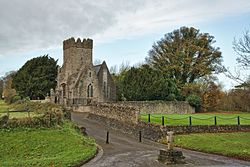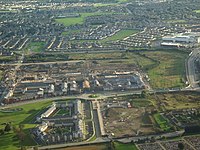Balgriffin
| Balgriffin | |
| County Dublin | |
|---|---|
 St Doulagh's Church, Balgriffin | |
| Location | |
| Grid reference: | O2110408 |
| Location: | 53°24’15"N, 6°10’46"W |
| Data | |
| Local Government | |
| Council: | Fingal |
| Dáil constituency: |
Dublin North-East |
Balgriffin is a village in County Dublin, sitting at the edge of the townscape spreading out from the City of Dublin. It is also a civil parish within the Barony of Coolock.[1]
Balgriffin is some five miles from Dublin city centre. It has an 18th-century public house, some cottages, a village green and hall, and two cemeteries - the older of which is to the west, the newer, civic, one to the east.[2][3]
The best known feature of the area is the early St Doulagh's Church.
The historic pub has been joined over the last decade by shops and eating facilities in southern Balgriffin.
Geography
The two main branches of the Mayne River, the Turnapin Stream and the Cuckoo Stream, run through the plains of the Balgriffin, picking up smaller streams. The Turnapin flows in the southern part of the area, coming from the old Belcamp Estate and running north of the main Belmayne development, while the Cuckoo comes east near Limekiln Lane and forms the northern boundary of the Fingal Burial Ground. Flooding sometimes hits Limekiln Lane. The Turnapin and the Cuckoo merge in eastern Balgriffin and the Mayne then flows out to Baldoyle Bay (Balgriffin Road becomes Moyne Road as it approaches the coast).
History
In 1388, Robert Burnell, judge of the Court of Exchequer, was lord of the manor of Balgriffin. His descendants, who were also lords of the manor of Castleknock, were still at Balgriffin in the seventeenth century. Historically, it has remained as a lightly settled area of fields with a hamlet at a crossroads, at which now stands the Georgian pub.
In 1542, King Henry VIII granted Conn Bacach O'Neill an estate in Balgriffin as a part of the Surrender and Regrant settlement that transformed the former King of Tir Eoghan into the newly designated 1st Earl of Tyrone.[4]
Development
Until recent years a small rural settlement, Balgriffin experienced several developments, including St. Samson's and Castlemoyne, and most notably the substantial one called Belmayne, infamous for its provocative advertising, and which remains unfinished.[5] This development was, in February 2011, the subject of urgent fire safety works, but without the evacuation of residents experienced in nearby Priory Hall, Donaghmede.[6]
Churches
- Church of Ireland: St Doulagh's Church, a mediæval church[7] It stands about half a mile north of Balgriffin hamlet
- Roman Catholic: Holy Trinity Church in Donaghmede, part of the Donaghmede Parish created in 1974
Features
St Doulagh's Church stands on a site which was originally a monastery, built in the 5th century. it is now a well known and much revered Church of Ireland church. The church was renovated in the 12th century after the Norman invasion.[8]
In the 5th century, Samson of Dol, a famous Welsh saint, made pilgrimage to Dun Etair (Contemporary Howth) and is said to have founded the monastery that is now St Doulagh's Church.[9][10] The church was originally under the patronage of St. Samson. As Balgriffin was in the past referred to as Ballygriffin and Griffinstown, the place name indicates that it was indeed settled by a Welshman.[11]
| ("Wikimedia Commons" has material about Balgriffin) |
References
- ↑ Placenames Database of Ireland - Balgriffin
- ↑ Balgriffin Cemetery
- ↑ Fingal Cemetery
- ↑ "Sir Sidney's Memoirs of his government in Ireland 1583" ULSTER JOURNAL OF ARCHEOLOGY First Series, Volume III, 1885. Pg. 46, footnote #6
- ↑ Dublin, Ireland: The Irish Times [1], retrieved Feb 23 2012
- ↑ Dublin, Ireland: The Irish Times [2], retrieved Feb 23 2012
- ↑ "St.Doulagh’s Church". United Parishes of Malahide, Portmarnock & St Doulagh's. http://www.malahide.dublin.anglican.org/blog.
- ↑ "St.Doulagh’s Church". http://www.malahide.dublin.anglican.org/blog/index.php/st-doulaghs-history.
- ↑ The life of St Samson of Dol by Thomas Taylor (Kessinger Publishing, LLC (July 25, 2007)): CNRS ISBN 0-548-09467-5
- ↑ The emergence of monasticism: from the Desert Fathers to the early Middle Ages By Marilyn Dunn (Blackwell Publishers Ltd, 2003): CNRS ISBN 1-4051-0641-7)
- ↑ Irish Saints of November: Duilech of Clochar: Memoir of the Church of St Duilech
